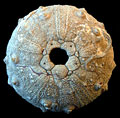The Echinoid Directory
Gymnocidaris Agassiz, 1838, p. 3
[=Hypodiadema Desor, 1858, p. 61, type species Hemicidaris saleniformis Desor, 1853; =Prodiadema Pomel, 1869, p. 38, type species Cidarites agassizi Roemer, 1839 ]
| Diagnostic Features |
|
|---|---|
| Distribution | Middle Jurassic (Callovian) to Lower Cretaceous (Valanginian) Europe. |
| Name gender | feminine |
| Type | Hemicidaris diademata Agassiz, 1838, p. 49, by subsequent designation of Lambert & Thiery, 1910, p. 168. |
| Species Included |
|
| Classification and/or Status |
|
| Remarks | Distinguished from Hemicidaris by the very rudimentary nature of the primary tubercles on adapical interambulacral plates. |




